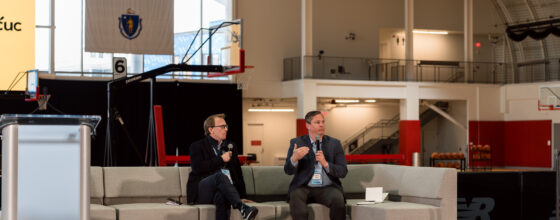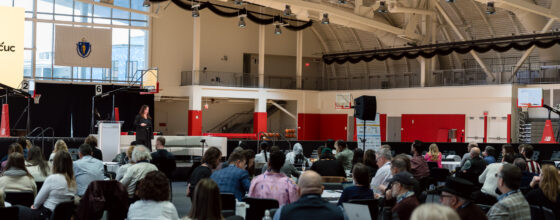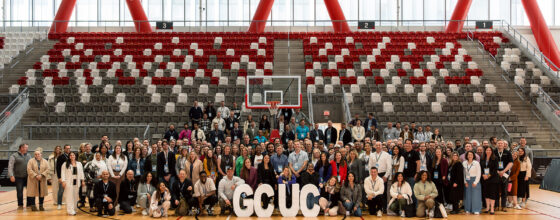Coworking & Flexible Workspaces Poised for Big Uptick Post-COVID

Original article published on June 22, 2020 – By Carolyn Cirillo on allwork.space. This post features highlights from a Knoll k. talks webinar discussing the future of work and why a hybrid model featuring HQs, regional flexible spaces, and home working could become our new normal.
- Speaking at a Knoll k. talk webinar, three flexible space experts discussed their thoughts on the next phase of the COVID-19 recovery and the future of work.
- Ryan Simonetti (Convene), Tim Rowe (Cambridge Innovation Center) and Liz Elam (GCUC) spoke with Knoll’s senior director of research Kylie Roth.
- The discussion covered distributed working, and why the future of work will likely incorporate a hybrid model featuring HQs, regional flexible spaces, and home working.
As a hybrid workplace emerges in the post-pandemic environment, and organizations roll out a distributed work strategy with both physical and remote locations, coworking and flexible spaces are poised to play a vital role in the transition and economic recovery.
Speaking at a Knoll k. talk webinar, three founders in the space-as-a-service industry shared their opinions on how coworking and flexible spaces play into the next phase of the work and meeting space business. Ryan Simonetti, CEO and co-founder of Convene; Tim Rowe, CEO and founder of Cambridge Innovation Center (CIC); and Liz Elam, founder of the Global Coworking Unconference Conference (GCUC), spoke with Knoll’s senior director of research Kylie Roth on why they expect significant upturns in the industry.

COVID has accelerated trends that were underway in the space-as-a-service category, a segment that typically operates at a higher-than-average level of speed and innovation. To survive and thrive in the post-pandemic climate, workspace operators will be required to pivot business models, update physical workspaces, enter new partnerships and launch new businesses.
Some key takeaways from the conversation:
In times of uncertainty, flexibility and agility are more important than ever
Panelists observed parallels between the current economic environment and the 2008 financial crisis.
The desire to outsource real estate accelerated in 2009 and 2010 as waves of people gravitated toward spaces that were more flexible as an alternative to signing five and 10-year leases in uncertain times.
“We’re hearing from our customers that flexibility is needed more today than probably ever before,” said Simonetti, who co-founded Convene on the heels of the 2008 financial crisis.
“And so, as we work our way through this crisis, not just in the short term or even medium to long term, I think that flex and coworking are a strategic part of that recovery and have a massive role to play within the industry at scale,” Simonetti noted.
Rowe concurred. “In October 2010, we saw revenues grow by about 50% during those 24 months immediately following the crisis. And I think something of that nature will happen again,” he said, noting that leading indicators were already showing strong recoveries in recently re-opened overseas locations.
Space-as-a-service will thrive in a more complex environment
As operations become more complex with new safety and security requirements, and compliance becomes more challenging, outsourcing becomes an appealing strategy for organizations that simply want to focus on their core competency and not worry about bringing physical workspaces up to stringent new standards. Enter space-as-a-service providers.
“The cost and complexity of running space today just increased exponentially,” Simonetti stated. Space operators are experts who focus solely on managing work, meeting and event spaces, and have well-developed infrastructure, talent and training strategies, and technology in place to manage a changing landscape.
“We are uniquely positioned because we’ve had to go through the process and the journey over the last 60 plus days to rethink the way that you actually fundamentally design, run, operate space and still deliver a premium hospitality experience in a post-COVID world,” explained Simonetti. “When I think about the future of flexible work and coworking, there’s a tremendous amount of value in the operating platforms and capabilities that we’ve built as companies.”
The future of work is distributed and that bodes well for coworking and flexible workspaces
When major organizations such as Barclays announce they will not return an entire workforce to a single stand-alone building, that signals a move to geographical diversification which is a win for suburban and rural coworking, noted Elam.
“So what we’re seeing happen, and research firms such as Instant have reported back, is a spike in corporations coming to them for spaces in smaller markets. There is going to be a big uptick because there is a big opportunity in this market and that’s not going away.”
“And we have seen that happen as Asia has come back,” added Elam, who produces coworking conferences on five continents. In CIC’s Warsaw location, where bars and restaurants have reopened, sales are actually ahead of pre-COVID predictions, according to Rowe.
It’s about choice
The industry is taking note of the unofficial results of the world’s largest coworking experiment.
Work from home only works for some people some of the time
“We’ve just almost completed the world’s largest work from home experiment,” Elam shared. “And what we figured out is that working with kids is not optimal. Working with dogs is not always optimal,” adding that while home isn’t always the best place to conduct work, it’s one of the great options.
For at least the last five to six years, choice, flexibility and experience have emerged as the three criteria that individual users – not companies – desire in the workspace, according to Simonetti whose firm has studied customer trends at both the individual and the company level since its founding.
Today, the desire and expectation for choice has never been stronger.
“In the past, most people didn’t really have the option to choose where they work,” said Simonetti. But post-COVID, things changed.
“People want choice. We’re one of the winning choices and we will continue to be so,” said Elam. “So, I think choice is going to be a big thing in the future and that does lead to flexibility,” she emphasized.
“A lot of people are really antsy to get back to work, some of the time,” observed Rowe. “They’re also saying, ‘Wow, work from home does kind of work and I want to do that more than I did before,’ so we’re going to see a mix there.”
“Some companies like Facebook and Twitter have said ‘Look, people can just work from home as long as they want,’” said Rowe. However, for all the predictions that larger companies may drop as much as half of their office space, he observed otherwise.
“There are so many businesses that did not want to go home. The people did not want to go home. They want to come back and right now they’re pushing the boundaries of when that’s okay, “ Rowe related.
Opinions were split on whether the in-office experience would focus on individual focus work, group meetings or a combination.
Many centers are currently designed as centric around individual work, which will change, Simonetti predicted.
“I think we’ve all just realized the issue with at-home work isn’t a productivity issue. It’s an engagement issue. And I think the HQ will need to be redefined to drive engagement and cultural connectivity in a way that it hasn’t in the past.
“The reality is you don’t have to go there to do heads down work. You can do that perfectly effectively when you’re at home.”
For every employee who comes to the office to meet in person, is a person with a home environment that does not allow them to concentrate, offered Kylie Roth, Knoll Senior Director of Workplace Research.
“One of the things we heard in many roundtables is people actually want to go into the office to be able to focus because they want to get away from the chaos of the kids and home,” she said.
We’re in a full opt-in choice-based model, panelists agreed. “I believe moving forward, at least for the next 12 to 18 months, there is not a CEO in the world that’s going to force somebody to show up at their office. And employees therefore have the choice to either work from home or work
from a coffee shop, my HQ or a third space,” Simonetti related.
Human’s need for community will drive us back to the office.
Our basic desire as social animals will be one of the strongest factors driving people back to the office, according to panelists.
Workplace = Community
“Working from home is actually hard and stressful at times,” said Elam. “We are humans and we crave and need community. So, people are really excited about going back to the office. People are going to flock back to spaces for meetings, for one-on-ones, for video conferencing options. So, it’s actually going to be a very good thing for the industry long term.”
“I think that there’s a natural human desire to be around other people to share your interests and so forth and I think you’re going to see that come back very strong,” agreed Rowe. “I actually think we’re going to be surprised at how quickly things move to a new normal.”
And once people return to a good shared workplace, we can expect them to be there for a very long time, according to Rowe, whose average client stay in CIC’s Cambridge facilities is now over six years. “So, this is longer than you’d spend in college. So, you’re choosing a community.
And so, you should ask: what does your community need to do for you?”
Wellness as the ultimate amenity
While the right amenities will continue to be an important draw to attract people back to the office, health and wellness will be among the most valued and desired amenity. Moreover, the workplace plays an integral role in health and wellbeing.
Can the workplace avert a pending mental health crisis?
Work from home has revealed some flaws in the model.
Coworking began as a way for people who did not want to work at home alone to create their own community and support network, Roth reminded the panel.
“Not everybody has a family, and there’s also a full-on loneliness epidemic. Before COVID, the number one most expensive thing facing all companies globally was depression,” said Elam.
“Do you think sending everybody home is making that better? No, it’s making it 10 times worse. So, we’re going to have a whole other crisis on our hands when the press stops paying attention to COVID and starts paying attention to the suicides, and the overdoses and all the other things that are still going on in the background. So, I think the amenities that are going to be highly valued in the future are really around not only physical health, but more around mental health,” said Elam.
Simonetti added, “We can’t underestimate the impact that this crisis has had on people’s mental well-being. We’re seeing that one of the most highly utilized amenities that Convene offers is access to the Eden Health platform.”
Keeping spaces healthy
Safety and health will be the top priority for operators for the short term, who are adapting spaces to allow for sufficient physical distancing, intuitive wayfinding and limited occupancy at individual and entire facility levels.
Outdoor spaces take on new importance when it comes to supporting wellness. Early studies from China show that the virus is virtually always transmitted in indoor settings, giving outdoor spaces greater currency. At CIC, a roof deck was reconceptualized as an outdoor conference room for the next few months.
While temperature and health checks will become the norm for the short-term in virtually all workplaces, and coworking and flexible workspaces are no exception, the pandemic has accelerated innovations that were underway. With a growing focus on health and wellness and human-centered spaces, it may not be surprising that telehealth is one category that is emerging as a leading new venture at innovation-centered coworking communities, incubators and accelerators, including CIC.
“We just launched a company to do COVID testing,” reported Rowe. “We’re aiming to do daily testing for employees and their families. We’re looking at antigen tests that are at an accessible price point and that don’t require a lab.”
Multi-pronged strategy + individual accountability help keep environments safe
Operators should utilize a series of safety and security methodologies so that, combined, they create the most effective barriers, or, what Rowe calls the Swiss cheese model where individual “slices” may have holes, but the whole block of cheese is solid.
“For example, masks have a few ‘holes’ because somebody is going to get around your mask requirement,” Rowe related. “Physical distancing actually works pretty well, but occasionally people go too close or airflow is such that it doesn’t quite work. When you stack up these ‘pieces of Swiss cheese’ and you hold it up, you’ll realize that there’s no ‘hole’ that goes all the way through.”
The blend of methods takes some of the onus off the operator and puts a greater emphasis on individual accountability.
Greater diligence and employee and member responsibility for their own health will ultimately benefit the greater good, panelists predicted. “We think that the workplace has actually become a safer place to be,” said Rowe.
“Premium and safe are now synonymous,” Simonetti added.
“There is a limit to what we as operators can do to keep people safe in an environment as dynamic as this virus that we still don’t know a ton about,” said Simonetti, whose firm worked President Obama’s Ebola czar and current adviser to Biden campaign Ron Klain, as well as leading medical specialists to develop standards. “The reality is, we’re six to nine months away from still having basic answers around this virus and immunity.”
“So we’re all in this together and we’re each accountable. We as an operator have our role to play, but then each of our members has their part of this that they have to own as well,” Simonetti said, noting that Convene created a new social contract; members that violate the standard are not allowed access.
At CIC, technology is integrated into the daily health check via a key system that reminds employees to complete their self-check, related Rowe.
Air-quality and filtration are behind-the-scenes amenities
“People are going to really value WELL certification,” related Elam, and in particular, will ask about the airflow in your building, she added.
Panelists agreed that much of making a building healthy centers on improving filtration, air quality and appropriate HVAC infrastructure, not only in their own spaces but in the overall building system, further cementing the importance of collaboration between space operators and service providers and the landlord.
Panelists predict extensive efforts and investments will be made behind the scenes to support a healthy environment for all occupants.
“It’s not the pretty sexy stuff that everyone sees out front” says Simonetti, “but that’s where I think the most exciting work will ultimately get done and will drive health and wellness long into the future.”
Creating psychological safety is equal or more important than creating physical safety and security.
In addition to extensive efforts creating a physically safe and secure environment, operators are focused on creating a perception of psychological safety, so people feel comfortable enough to return to their spaces.
Communicating those efforts is one of the most valuable ways to make members feel safe and secure according to Elam. “Everybody’s done all the hard work, and now we’ve got to tell you about it,” she said.
The new coworking and flexible workplaces are phygital
Flexible workplace businesses must pivot to survive and thrive in the new normal. In most cases, the new model is a blend of a physical and digital offering.
Much like organizations can expand their talent search when geographical barriers are removed with work-from-home-programs, phygital offerings provide a similar freedom from physical inventory constraints.
In order to compete, smaller independent providers will need to leverage technology-driven aggregators such as the Instant Group to reach corporate users seeking space in small markets, advised Elam.
Convene has shifted to meet its customers wherever they may be with its new Convene 2.0 hybrid that seeks to be a firm’s default third space provider. “We want to be able to deliver our clients a great day at work wherever they are. And when I think about the future of work, I think it’s hybrid. It’s HQ. It’s third space which I think coworking and flex space is a huge part of that. And now it’s going to be a growing at home and remote workforce.”
“That’s very much the direction that we’re going, which is decoupling Convene from physical space, and really leveraging our technology, our human services, our design capability to bring that to our client’s space and then to an at-home workforce, to support a growing remote and virtual workforce,” described Simonetti.
The future of meetings is hybrid. And for now, smaller.
For the near term, the large-scale meetings business is slow. “I think it’s going to be some time before people feel comfortable or if it’s even legal to bring 300, 400 or 500 people together in the same space,” said Simonetti, who is pivoting to a focus on smaller gatherings and a hybrid platform.
“We are seeing a lot of demand for small gatherings where people need to and want to come together, especially in times like this where strategy and collaboration is a critical part of your ‘survive-then-thrive’ strategy. The only way to do that is by bringing people physically together face to face. So we’re seeing a lot of that demand for the second half of this year into next year.”
Simonetti anticipates most meetings going forward will be hybrid with both a physical and live streaming component and is adding a virtual conferencing element to Convene’s meeting platform.
Designed for larger scale internal and external conferences and events, it features an improved user interface and experience with a dedicated service component intended to mimic the physical experience enhanced with Convene’s premium service and technology factors for a seamless online event.
“That’s not just a short-term trend. We do think that will continue to be a larger and larger part of our business, and it’s beautiful because we’re not bound by physical inventory anymore. We’re hosting virtual conferences for customers in cities where we don’t have Convene locations. And so, it’s a really, really exciting part of our business, and, an area where we’re investing a lot of time and energy to really expand that offer.”
Looking ahead
As the demand for long term flex space grows, panelists predicted continued specialization of spaces, consolidation, and growth of certain companies that have quality operations and platforms that scale.
“I do think consolidation will happen over the next 12 to 24 to 36 months,” said Simonetti. “It’s a natural part of the evolution of the industry. And I think that will become less about the virus and more about its economic impact.”
“I think needing scale allows you to afford to spend on things like the product, sales, marketing — things that tend not to get cheaper over time but more expensive. I do think you will see more players over time really starting to specialize in certain niches whether that’s by geo or by demographic.”
Rowe sees deeper capabilities as the next stage, such as the robot-building space at CIC Cambridge.
It’s analogous to a hotel model, Rowe explained. “Not every hotel caters to the same audience at the same price point. Some are more family oriented; some are more business oriented and so forth.”
Innovation is a Given
One thing we can count on is that coworking and flex work will be centers of innovation.
“We’re all innovating really fast. We’re trying totally new things,” noted Rowe. “I would never have thought we would launch a health company and be doing COVID testing, and building a business around that, so I think we’re going to see some unexpected things come out of this.
“And thank you to all of you for staying along for the ride. As Ryan said at the beginning, coworking has an incredible ability to deliver a higher, better experience of working, whether it’s at home or at work, than what we ever experienced in the past and in traditional companies, so I’m excited for it.”








